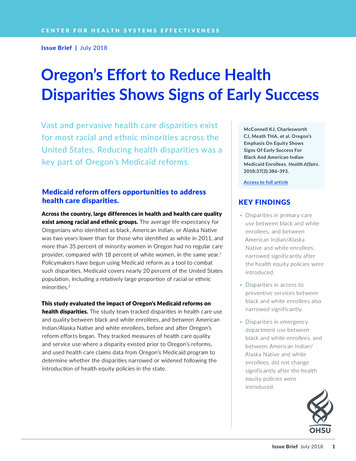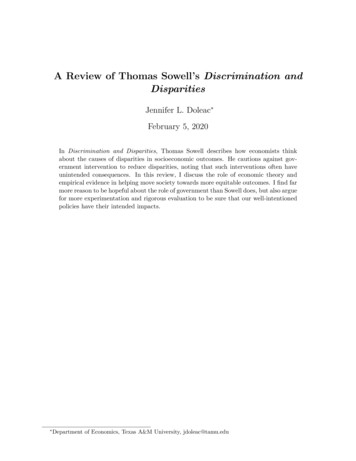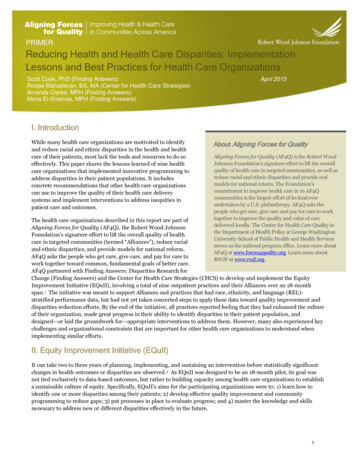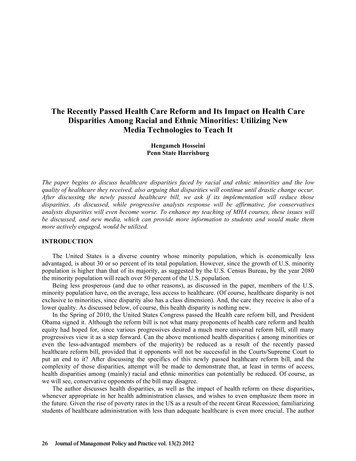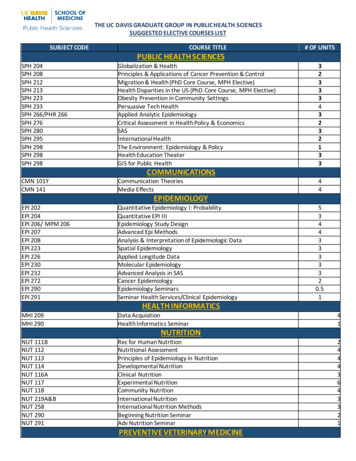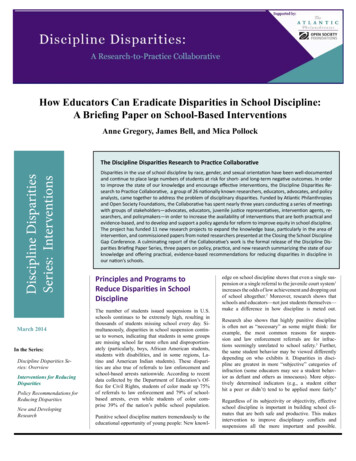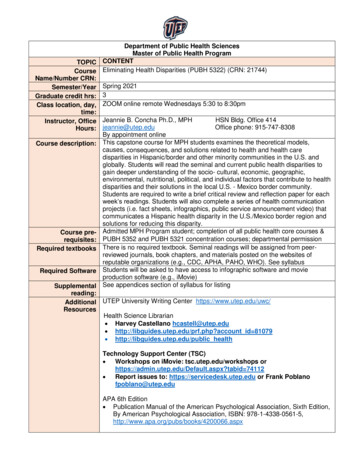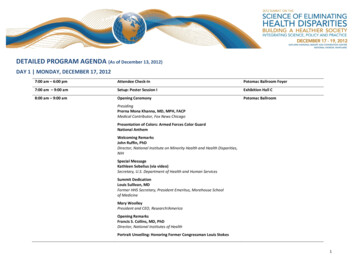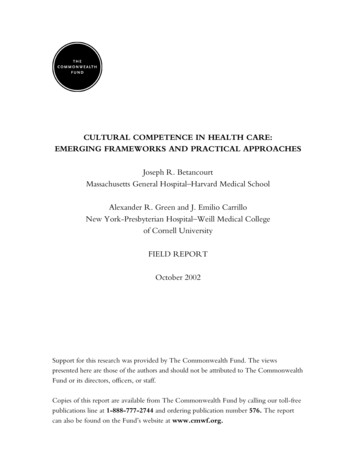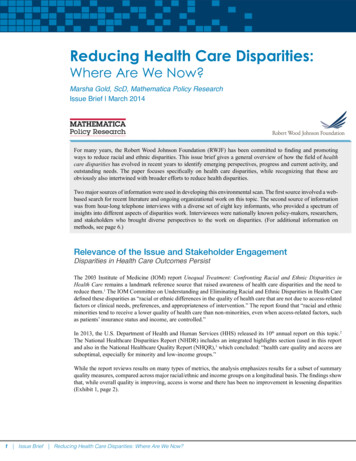
Transcription
Reducing Health Care Disparities:Where Are We Now?Marsha Gold, ScD, Mathematica Policy ResearchIssue Brief March 2014For many years, the Robert Wood Johnson Foundation (RWJF) has been committed to finding and promotingways to reduce racial and ethnic disparities. This issue brief gives a general overview of how the field of healthcare disparities has evolved in recent years to identify emerging perspectives, progress and current activity, andoutstanding needs. The paper focuses specifically on health care disparities, while recognizing that these areobviously also intertwined with broader efforts to reduce health disparities.Two major sources of information were used in developing this environmental scan. The first source involved a webbased search for recent literature and ongoing organizational work on this topic. The second source of informationwas from hour-long telephone interviews with a diverse set of eight key informants, who provided a spectrum ofinsights into different aspects of disparities work. Interviewees were nationally known policy-makers, researchers,and stakeholders who brought diverse perspectives to the work on disparities. (For additional information onmethods, see page 6.)Relevance of the Issue and Stakeholder EngagementDisparities in Health Care Outcomes PersistThe 2003 Institute of Medicine (IOM) report Unequal Treatment: Confronting Racial and Ethnic Disparities inHealth Care remains a landmark reference source that raised awareness of health care disparities and the need toreduce them.1 The IOM Committee on Understanding and Eliminating Racial and Ethnic Disparities in Health Caredefined these disparities as “racial or ethnic differences in the quality of health care that are not due to access-relatedfactors or clinical needs, preferences, and appropriateness of intervention.” The report found that “racial and ethnicminorities tend to receive a lower quality of health care than non-minorities, even when access-related factors, suchas patients’ insurance status and income, are controlled.”In 2013, the U.S. Department of Health and Human Services (HHS) released its 10th annual report on this topic.2The National Healthcare Disparities Report (NHDR) includes an integrated highlights section (used in this reportand also in the National Healthcare Quality Report (NHQR),3 which concluded: “health care quality and access aresuboptimal, especially for minority and low-income groups.”While the report reviews results on many types of metrics, the analysis emphasizes results for a subset of summaryquality measures, compared across major racial/ethnic and income groups on a longitudinal basis. The findings showthat, while overall quality is improving, access is worse and there has been no improvement in lessening disparities(Exhibit 1, page 2).1 Issue Brief Reducing Health Care Disparities: Where Are We Now?
Exhibit 1. Number and Proportion of All Quality Measures that Are Improving, Not Changing,or Worsening, Overall and for Select PopulationsImprovingNo ChangeWorsening100Percent806040200Source: Agency for Healthcare Research and Quality. National Healthcare Disparities Report 2012.Note: For each measure, the earliest and most recent data available to our team were analyzed; for the vast majority of measures, thisrepresents trend data from 2000 2002 to 2008 2010.Key: n number of measuresImproving Quality is going in a positive direction at an average annual rate of greater than 1% per year.No Change Quality is not changing or is changing at an average annual rate of less than 1% per year.Worsening Quality is going in a negative direction at an average annual rate of greater than 1% per year.Reducing Health Care Disparities to Achieve More Equitable Health Care OutcomesRemains a Goal of U.S. Public PolicyIn its review of where disparities fit into its five-year strategic plan,4 HHS identifies three specific goals: Achieve health equity as outlined in the HHS Action Plan (discussed below) and through actions that help betterlink patients to a usual primary care source, increase the number of patient-centered medical homes (PCMHs),and enhance support for community health centers. Ensure access to quality, culturally-competent care for vulnerable populations by improving the culturalcompetency and diversity of the health care workforce and addressing disparities in access to care. Improve data collection and measurement of health data by race, ethnicity, sex, primary language, and disabilitystatus, as well as other efforts in planning for the collection of additional data.In 2011, HHS released its Action Plan to Reduce Racial and Ethnic Health Disparities under the leadership of theOffice of Minority Health.5 Its vision is a “nation free of disparities in health and health care.” Overarching secretarialpriorities involve heightening the impact of all HHS actions to achieve this goal, particularly by improving theavailability, quality, and use of data; measuring disparities in health care; and providing incentives to improve healthcare for minorities. Concurrent with the release of the Action Plan, HHS also released a national stakeholder strategyto reduce disparities, developed through the National Partnership for Action to End Health Disparities, which ithelped convene.6More Tools Now Exist to Support Measuring Disparities andUndertaking InterventionsEnhanced capacity for subgroup analysis. In response to the limitations in available national data for monitoringrace and ethnic disparities in health care as well as new Affordable Care Act (ACA) requirements in this area, onOctober 31, 2011, HHS released new, refined standards for capturing race, ethnicity, sex, and primary language ordisability in individual person-level surveys.7 The standards for demographic data apply to HHS-sponsored surveys2 Issue Brief Reducing Health Care Disparities: Where Are We Now?
in which respondents (knowledgeable informants) self-report information. While such standards do not apply toadministrative data, providers have additional incentives to collect such data if they want to receive Medicareand Medicaid incentive payments under the Health Information Technology for Economic and Clinical Health(HITECH) Act. The Stage 1 requirements in place since 2010 include, among the core standards, recording patientdemographics as structured data. Such demographics need to include preferred language, gender, race, ethnicity,and date of birth.New metrics exist for assessing cultural competency and language services. New consensus metrics are beginningto become available for assessing whether training and other developments are generating changes in the availabilityof those culturally-competent care and language services viewed as critical to reducing disparities in health care. TheNational Quality Forum (NQF) is a public-private partnership that works on a consensus basis across stakeholders toagree on appropriate measures for endorsement. In 2012, NQF issued its first endorsements specifically addressinghealth care disparities and cultural competency. After several years of work, the panel endorsed 12 of the 16 measuresunder consideration.8 These standards cover areas such as office practice communications infrastructure, patientreports on health literacy and cultural competency, patient receipt of language services, and implementation ofcultural competency standards. HHS continues to work with its partners on the implementation of policy and practicestandards regarding culturally and linguistically appropriate services (CLAS). The National Committee for QualityAssurance (NCQA), a national nonprofit organization that works extensively in the area of health care quality, hasdeveloped voluntary accreditation standards for CLAS that include the collection and use of race, ethnicity, andlanguage data.9Stakeholders Are Working to Support Better Capturing of Data Required to AssessHealth Care DisparitiesHospitals. In 2007, the Health Research and Educational Trust (HRET) released a toolkit that hospitals can use tocollect race, ethnicity, and language data on their patients. The American Hospital Association (AHA) platform forperformance improvement is “Hospitals in Pursuit of Excellence,” or HPOE, formed in 2011. An AHA national surveyshowed that only 18 percent of hospitals in 2011 were collecting race, ethnicity, and language data at the first patientencounter, even though these data are needed to assess gaps in care. Under HPOE, a coalition of organizations—AHA,the Association of American Medical Colleges, the Catholic Health Association of the United States, the AmericanCollege of Healthcare Executives, and America’s Essential Hospitals (formerly the National Association of PublicHospitals and Health Systems)—are working together with the goal of increasing the collection of race, ethnicity,and language data (REAL) from a baseline of 18 percent (2011) to 75 percent (2020); increasing cultural competencetraining from a baseline of 81 percent (2011) to 100 percent (2020); and increasing diversity in governance andleadership from 14 percent and 11 percent, respectively, at the baseline (2011) to 20 percent and 17 percent (orreflective of community served), respectively (2020). In August 2013, HPOE released an Equity of Care documentaimed at helping hospitals and health systems improve the way they collect and use race, ethnicity, and language data.Physicians. The American Medical Association (AMA) Commission to End Health Disparities—which first formedin 2004 in collaboration with the National Medical Association and was joined by the Hispanic Medical Associationsoon afterward—is working to encourage physicians to be concerned with health care disparities. According to itsmost recent strategic plan, the group has 71 affiliated organizations.10 Its focus is to educate health professionals ondisparities and cultural competency, increase the diversity of the workforce, advance policy and advocacy initiativesin this area, and improve data collection and research to identify and eliminate disparities. The work appears to be amember-led activity, with an agenda that is broad, although not highly resourced.Health plans. Health plan work centers most visibly around the National Health Plan Collaborative (NHPC). Itbegan with nine large national and regional firms in the industry, whose efforts were co-sponsored by the Agency forHealthcare Research and Quality (AHRQ) and RWJF from 2004 to 2008. The NHPC has been based within America’sHealth Insurance Plans (AHIP) since its external funding support ended. As with providers, data collection to identify,monitor, and track progress on health care disparities is an ongoing challenge. While such data collection practices arenot tracked routinely, AHIP, with the support of RWJF, has surveyed its members to identify the status and trends ofsuch data collection. The most recent results from a 2010 survey have been profiled to highlight both accomplishmentsand ongoing challenges.113 Issue Brief Reducing Health Care Disparities: Where Are We Now?
Gauging Progress and AccomplishmentsContinued Relevance of Capturing Data on Race, Ethnicity, Language, and OtherMetricsBoth interviewees and our review of the literature reinforce the ongoing relevance of data collection in seekingto reduce health care disparities. We were told by interviewees that “measurement is still very much an issue”and “this is still a BIG ISSUE.” Even those who sought progress observed that “we have a long way to go.” Moreprogress has been made in capturing disparities data through surveys than in administrative records, includingprovider and health plan data.Among the barriers to better data collection on race, ethnicity, and other factors, two appear to have particularpolicy relevance. First, interviewees said that collecting such data requires an organization to be committed to itspursuit. With many demands on their time and resources, providers and health plans will find the “business case”for such collection to be weaker to the extent that important customers (e.g., regulators, purchasers) do not makecollection and use of such data a condition of doing business. Second, inconsistencies and the lack of operationalspecificity in existing tools limit the usability and quality of the data collected.A Desire to Move Toward Effective InterventionMany of the interviewees expressed impatience with data collection that does not lead to intervention, viewing dataas just one piece of an ongoing infrastructure for disparities reduction. In addition, in an increasingly multiculturalsociety, interviewees said it is relevant to consider how refined metrics must be, given that individuals vary on somany dimensions. But they also noted that without data, it is very difficult to assess priorities or progress in reducingdisparities in quality and outcomes.Most of those interviewed felt that while more research on effective interventions could always be valuable, sufficientknowledge is available at this point to take steps to intervene effectively; they encouraged progress in this direction.The literature lends some support to this view.12One area of tension around intervention concerns “evidence.” A number of interviewees stressed the contextualdependence of intervention design and strategy. A second issue involves assumptions about causal logic. Ourinterviews suggest that there is some debate regarding interventions to improve health care disparities over whetherthe problem is unequal treatment within a practice, or the effect race/ethnicity has on the providers’ availability andquality of care. In reality, both are probably at work.Linking Disparities to Quality of Care, Delivery System Change, and Payment PolicyInterviewees and the literature clearly link health care disparities to a quality agenda. National tracking efforts nowmore clearly allow for integrating analysis of quality with a disparities focus because the same metrics are used forboth, and a common summary is used across the NHDR and NHQR. Interviewees noted that in delivery settings,disparities initiatives also tend to be located in quality improvement offices. Most interviewees, however, thoughtthat the link was more theoretical than real. The main reason is because stratification of quality metrics by race andethnicity is not central to most quality improvement or monitoring efforts.Interviewees had a similar reaction to the role delivery system and payment policy change could have in reducingdisparities. In general, interviewees were very supportive of changes in payment policy to reward better separatereporting by race or ethnicity (subject to sample size constraints) but did not see many policy initiatives that do so. Fewinterviewees believed that disparities were now on the radar screen of PCMHs and accountable care organizations(ACOs), for example. According to interviewees, the Centers for Medicare & Medicaid Services (CMS) is not amajor player in the disparities field at this time. However, some expressed the hope that this would change andthought some internal activity might be underway that could expand interest in this area.Trade-Offs Exist in Expanding the Focus of Disparities EffortsOur review of current activity makes clear that federal policy, and many organizations across the board, increasingly4 Issue Brief Reducing Health Care Disparities: Where Are We Now?
view health care disparities broadly. HHS’s strategic plan, for example, identifies many groups for attention basedon race, ethnicity, religion, socioeconomic status, gender, age, mental health, disability, sexual orientation, genderidentity, geographic location, and other factors. There also appears to be a shift from the concept of disparities to oneof equity. The shift provides more focus on action and social justice relevant to a wide variety of subpopulations.Those we interviewed saw advantages in reframing the issue this way. Probably the most relevant from the perspectiveof race and ethnic disparities is that reframing has the potential to increase relevance and broaden population supportbecause more people could see the relevance of equity to them. There are potential downsides, however. Whilemost interviewees attributed to others the concerns that a broad equity agenda could diffuse the focus on particularsubgroups and tax available resources, many of them also mentioned this issue.There are some practical challenges to a broader definition of disparities, at least in monitoring and interventions.Data to define disparities are currently much more limited for some subgroups than others; LBGT and disabilitystatus data lag behind other data. Further, while many people portray a variety of characteristics, the logical chain ofprocesses that leads to disparities based on particular characteristics is likely to differ by particular characteristic. Anobvious example relates to disability, where care is challenged by potential physical and other barriers.Among subgroups, race/ethnicity and income or socioeconomic status have the longest historical link; indeed theyoften are thought of as interrelated concepts. Some interviewees thought that recent ACA-related eligibility rulesfor coverage might enhance the availability of income data, at least at the bottom of the distribution. Others saidthat education could serve as a proxy. In an ACA environment, considerable interest was expressed in looking at theextent to which reduction in disparities might be associated with coverage, and what the remaining disparities mightindicate about the role of other factors.Perspectives on Gaps and Useful Future WorkThose we interviewed brought different perspectives to the disparities issue. Their perspectives on gaps and future workwere shaped by whether they were based mainly within a national policy, operational and local delivery, or researchperspective. Suggestions for future activity often drew upon that individual’s experience and organizational base,stressing areas in which support would be useful to their interests in health care disparities. Generally, intervieweestended to see four major gaps in current work. Cross-Cutting Leadership to “Connect the Dots.” While many initiatives are underway in the health care disparitiesfield, interviewees felt that less attention was being paid to the broader context and logic of work to reduce healthcare disparities regarding how various initiatives or interventions relate to one another, and why they are important. Aligning Policy and Payment with Disparities Goals. While there is more attention than in the past to encouragework around disparities within the operational setting, various interviewees thought that policies stating that suchwork is both feasible and necessary were still limited. Such policies could be linked to requirements that providersreport performance metrics by race and ethnicity. More broadly, interviewees felt that payment is needed to supportsustainable interventions. For example, an initiative might pay navigators to improve care for minorities, but theintervention will not be sustainable if the payment system does not generate ongoing support to maintain such apresence after the pilot ends. Support for Building Infrastructure for Effective Local Interventions. Interviewees actively engaged withprovider and community-based interventions felt there still was insufficient support for effectively applying localinterventions in the marketplace. They also were interested in bringing greater knowledge of social determinantsto effective local interventions. Some wished funders would place more emphasis on those efforts oriented towardmobilizing action versus trying to teach researchers how to translate research into action. Leveraging Opportunities of the ACA. With both coverage expansion and delivery reform high on the nation’s radarscreen as ACA implementation moves forward, some interviewees saw this general awareness as possibly leadingto opportunities for focusing on work on health care disparities. For example, given that the ACA is likely to expandcoverage, what will be the short- and long-term effects of such change on health care disparities? How will theACA’s expanded payments for primary care affect Medicaid beneficiaries, many of whom are minorities? Will themovement to medical homes encourage work with community organizations and focus more attention on the role ofsocial determinants in affecting health outcomes? Another interviewee saw a need to increase the emphasis on howto implement ACA provisions to improve equity and reduce disparities by encouraging best practices.5 Issue Brief Reducing Health Care Disparities: Where Are We Now?
In sum, there is a need for work both at the national policy and local care delivery levels in communities. In bothcases, there is value in working to integrate disparities into a broader set of goals by encouraging measurement,priority setting, and interventions sensitive to the most vulnerable members of society. Further, community-basedinterventions will be more effective if they take into account both community and medically focused forces thatinfluence health outcomes, so that the two are self-reinforcing. None of this work is easy, and all of it is likely torequire a prolonged commitment.MethodsThe project spanned a four-month period starting on August 15, 2013. The emphasis was on recent activity and perspectivesrelated to health care disparities—generally work from around 2009. Consistent with the thrust of the work of RWJF andmany previous efforts in the United States, we placed special emphasis on examining work on racial and ethnic disparitiesin health care, including efforts at measurement and interventions. The review sought to place this work in the context ofhealth care disparities work in general, however, including recent efforts to broaden its scope to other population subgroupsand link disparities to emerging work on quality improvement overall.Two major sources of information were used in developing this environmental scan. The first source involved a web-basedsearch for recent literature and ongoing organizational work on this topic. The intent was to identify seminal efforts andexamples of activity underway by various key stakeholders, rather than provide an exhaustive and comprehensive reviewof the literature and all ongoing activity.The second source of information was from hour-long telephone interviews with a diverse set of eight key informants,who provided a spectrum of insights into different aspects of disparities work. We identified those to be interviewed inconsultation with RWJF. Interviewees were nationally known policy-makers, researchers, and stakeholders who broughtdiverse perspectives to the work on disparities. A semi-structured protocol, sent to interviewees in advance, guided theinterviews. We told interviewees that the facts regarding their work might be shared in attributed form but the perspectivesthey provided would not be identified individually. All of those who were solicited agreed to participate.This project was conducted by Mathematica Policy Research through a grant from the Robert Wood Johnson Foundation.6 Issue Brief Reducing Health Care Disparities: Where Are We Now?
Endnotes1.Smedley BD, Stith AY and Nelson AR (editors). Unequal Treatment: Confronting Racial and Ethnic Disparities in HealthCare. Institute of Medicine (IOM), Committee on Understanding and Eliminating Racial and Ethnic Disparities in Health Care.Washington, DC: National Academy Press, 2003.2.Agency for Healthcare Research and Quality (AHRQ). 2012 National Healthcare Disparities Report. Rockville MD: U.S.Department of Health and Human Services (HHS), AHRQ Publication No. 13-003, May 2013, 2/nhdr12 prov.pdf.3.Ulmer C, Bruno M and Burke S (editors). IOM. “Future Directions for the National Healthcare Quality and Disparities Reports.”Washington, DC: National Academy Press, 2010.4.U.S. HHS. Strategic Plan 2010–2015. Washington, DC: HHS, 2010, .U.S. HHS. HHS Action Plan to Reduce Racial and Ethnic Health Disparities: A Nation Free of Disparities in Health and HealthCare. Washington DC: HHS, 2011, al Partnership for Action to End Health Disparities. National Stakeholder Strategy for Achieving Health. WashingtonDC: U.S. Department of Health and Human Services, 2011.7.U.S. HHS. Final Data Collection Standards for Race, Ethnicity, Primary Language, Sex, and Disability Status Required bySection 4302 of the Affordable Care Act. Washington, DC: HHS Office of Minority Health, 2011, .aspx?lvl 2&lvlid 208.8.National Quality Forum (NQF). Endorsement Summary: Healthcare Disparities and Cultural Competency Measures.Washington DC: National Quality Forum, August 2012, http://www.qualityforum.org/Projects/h/Healthcare Disparities andCultural Competency/Healthcare Disparities and Cultural Competency.aspx.9.HPOE. Reducing Health Care Disparities: Collection and Use of Race, Ethnicity and Language Data. Chicago: AmericanHospital Association, American Medical Association, Catholic Health Association of the United States, American College ofHealthcare Executives, and America’s Essential Hospitals, August 2013.10. American Medical Association. Commission to End Health Care Disparities. Chicago: American Medical Association, health/cehcd-strategic-plan.pdf.11. Nerenz DR, Carreon R and Veselovskiy G. Race, Ethnicity and Language Data Collection by Health Plans: Findings from2010 AHIPF-RWJF Survey. Journal of Health Care for the Poor and Underserved, 24(4): 1769–1783, 2013.12. Chin M, Clarke AR, Nocon RS, et al. “A Roadmap and Best Practices for Organizations to Reduce Racial and EthnicDisparities in Health Care.” Journal of General Internal Medicine, 27(8): 992–1000, 2012.7 Issue Brief Reducing Health Care Disparities: Where Are We Now?
encounter, even though these data are needed to assess gaps in care. Under HPOE, a coalition of organizations—AHA, the Association of American Medical Colleges, the Catholic Health Association of the United States, the American College of Healthcare Executives, and America's Essential Hospitals (formerly the National Association of Public
